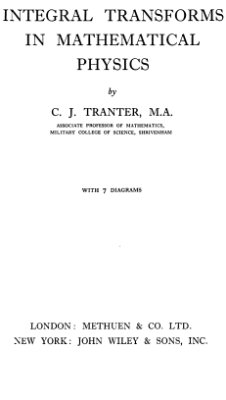Methuen & Co, 1966. - 126 pages.
The classical methods of solution of the boundary-value problems of mathematical physics may be said to be derived from Fourier's pioneer work. Another technique, that of integral transforms, which had its origin in Heaviside's work, has been developed during the last few years and has certain advantages over the classical method. It is the purpose of this monograph to give an outline of the use of integral transforms in obtaining solutions to problems goveed by partial differential equations with assigned boundary and initial conditions.
Heaviside (about 1890) was originally interested in the solution of the ordinary differential equations with constant coefficients occurring in the theory of electric circuits. Later he extended his method to the partial differential equations occurring in problems of electro-magnetism and heat conduction. The power of his method was such that he solved many hitherto intractable problems and obtained solutions to problems already solved in a form better adapted for numerical computation. Later investigations by Bromwich, Carson and van der Pol placed the Heaviside calculus on a sound foundation.
The theory developed by Heaviside, Bromwich and Carson has been unified in recent work by Doetsch (and others) on the Laplace transformation. The solution found from Heaviside's calculus is obtained from Laplace's integral equation and the contour integral appearing in Bromwich's work is the integral in the inversion theorem for the Laplace transform.
The classical methods of solution of the boundary-value problems of mathematical physics may be said to be derived from Fourier's pioneer work. Another technique, that of integral transforms, which had its origin in Heaviside's work, has been developed during the last few years and has certain advantages over the classical method. It is the purpose of this monograph to give an outline of the use of integral transforms in obtaining solutions to problems goveed by partial differential equations with assigned boundary and initial conditions.
Heaviside (about 1890) was originally interested in the solution of the ordinary differential equations with constant coefficients occurring in the theory of electric circuits. Later he extended his method to the partial differential equations occurring in problems of electro-magnetism and heat conduction. The power of his method was such that he solved many hitherto intractable problems and obtained solutions to problems already solved in a form better adapted for numerical computation. Later investigations by Bromwich, Carson and van der Pol placed the Heaviside calculus on a sound foundation.
The theory developed by Heaviside, Bromwich and Carson has been unified in recent work by Doetsch (and others) on the Laplace transformation. The solution found from Heaviside's calculus is obtained from Laplace's integral equation and the contour integral appearing in Bromwich's work is the integral in the inversion theorem for the Laplace transform.

